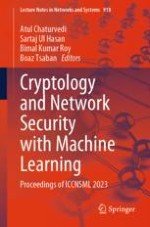The book features original papers from International Conference on Cryptology & Network Security with Machine Learning (ICCNSML 2023), organized by PSIT, Kanpur, India during 27–29 October 2023. This conference proceeding provides the understanding of core concepts of Cryptology and Network Security with ML in data communication. The book covers research papers in public key cryptography, elliptic curve cryptography, post-quantum cryptography, lattice based cryptography, non-commutative ring-based cryptography, cryptocurrency, authentication, key agreement, Hash functions, block/stream ciphers, polynomial-based cryptography, code-based cryptography, NTRU cryptosystems, security and privacy in machine learning, blockchain, IoT security, wireless security protocols, cryptanalysis, number theory, quantum computing, cryptographic aspects of network security, complexity theory, and cryptography with machine learning.
